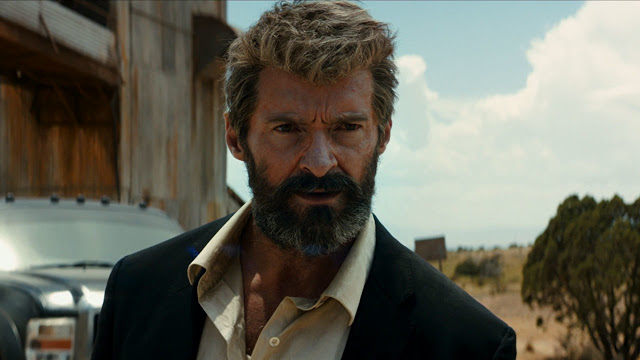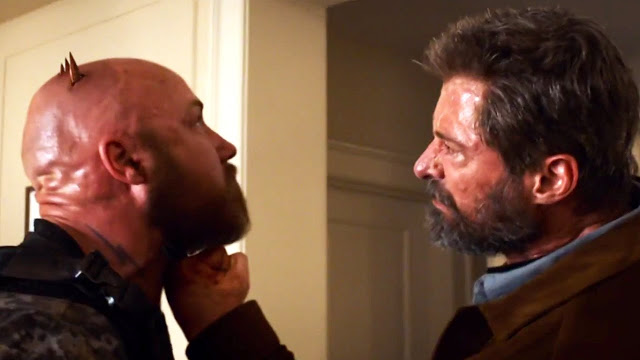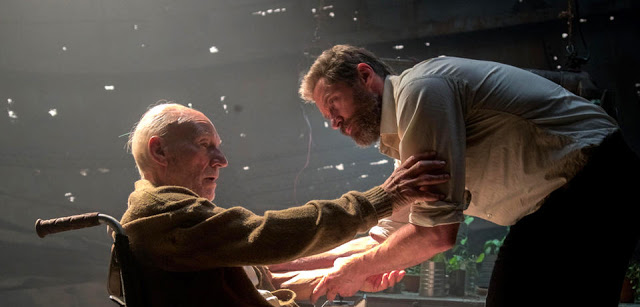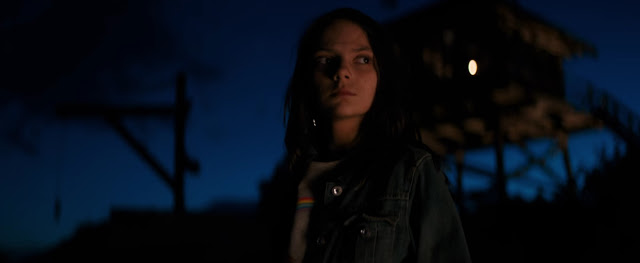The most valid criticism of Marvel movies is that they’re all the same. That’s an exaggeration, certainly, but there’s an undeniable whiff of formula that pervades the MCU, a familiarity that sometimes slips into complacency. The oversized casts, the pithy banter, the FX-laden fight scenes, the mundane aesthetic, the cameos and the fan service and the post-credits stingers—all of these combine to form a brand that, while powerful and successful, threatens innovation and disdains originality. (My favorite MCU entry, Guardians of the Galaxy, is delightful in part because it is only tenuously connected to its eponymous universe.) Some of the individual titles are good, others are bad, but few even try to be great.
Logan, the seventh movie to feature Hugh Jackman as the Wolverine (ninth if you count his single-scene appearances in X-Men: First Class and X-Men: Apocalypse), is not a great movie. Its villains are bland, its action sequences are mediocre, and its pacing is occasionally sluggish. These are flaws that would cripple most comic-book movies. But Logan, which was directed by James Mangold from a script he wrote with Scott Frank and Michael Green, is not most comic-book movies. A welcome outlier in a cinematic landscape of alarming uniformity, it is decidedly unlike its peers: bold, thoughtful, and surprisingly powerful. Above all, it is distinctive.
This derives in part from its extremity. In an era where studios slavishly adhere to the PG-13 mandate—where the bludgeonings are bloodless, the sex discreet, and the curse words carefully curated—Logan is brazenly R-rated, with grisly violence and torrential profanity. (A glimpse of bare breasts seems to have been thrown in just to complete the trifecta.) This is commendable if only because it represents a refusal to kowtow to the arbtirary tyranny of the MPAA and its myriad absurdities. (In a wry meta moment, Logan questions the wisdom of shielding a child from “a few naughty words” when she’s already been exposed to horrifying atrocities.) All the same, it’s important not to ascribe too much maturity to Logan’s excess; Deadpool was equally foul-mouthed, and it’s as childish a movie as you can find. No, Logan’s rareness extends far beyond its vulgarity and brutality.
A more notable feature may be its geography. Set far from the densely populated cities that house most comic-book films, Logan is in many ways a throwback Western, opening in Texas and slowly traversing its way north through Middle America. (It’s a lot like American Honey, only with more killing and fewer magazine sales.) Shooting on dusty roads and in arid deserts (filming took place in Louisiana and New Mexico), Mangold gives the picture a weary, burnt-out feel, which helps accentuate the fatique and cynicism that plague its title character.
And plagued he is. A freakishly in-shape actor, Jackman has always pulled off the immortal Wolverine’s agelessness, which makes his 180 of a portrayal here all the more startling. With a thick grey beard and flinty eyes, the Logan of this film seems a half-century removed from the leather-clad superhero who scaled the Statue of Liberty for Bryan Singer all those years ago, or even the solitary faux-samurai of Mangold’s The Wolverine. Often drunk and always grouchy, the ex-X-man is now a surly limousine driver, numbly ferrying clients to and fro. He’s living in a dystopian post-X-Men future where mutants have purportedly gone extinct. Years ago, Logan teamed with fellow legends to fight evil and save the world. Now, his primary goal is to scrape together enough cash to buy a boat and sail off into the dreary sunset.
If you think Logan’s condition has worsened, wait till you get a look at Professor X. Played once again by Patrick Stewart, Charles Xavier has deteriorated from the coolly omniscient telepath of the X-Men comics to a feeble old man in the grips of dotage. Senile and helpless, Charles requires regular injections, without which he loses control of his power and sends everyone around him into fits of agonizing paralysis. Along with Caliban (an unrecogzniable Stephen Merchant), an albino who can sense fellow mutants, Logan must dutifully care for Charles, who is constantly rambling about unseen figures, and who appears to be at death’s door.
Visually, Logan may look like a Western—the barren plant where Logan and Caliban nurse Charles isn’t too far removed from the tranquil homesteads of True Grit and Once Upon a Time in the West, the peaceful towns invariably threatened by black hats—but structurally, it’s more of a “one last job” movie, the kind where the inveterate crook needs to pull off one final heist before retiring from a life of crime. For Logan, that opportunity comes from Gabriela (Orange Is the New Black’s Elizabeth Rodriguez), a jittery woman who seeks passage to North Dakota for herself and her mute 11-year-old ward, Laura (Dafne Keen, a born thief of scenes). The money is too good to pass up, but surprise surprise, things get hairy. Before long, Gabriela has been murdered, Caliban has been kidnapped, and Logan is fleeing across the desert with Charles and Laura, pursued by a cadre of those aforementioned black hats, here led by a prosthetic-handed sleazeball named Pierce (Boyd Holbrook, from Narcos).
And this is where Logan gets gratifyingly weird. Whereas action sequences represent the raison d’être of most comic-book films, Logan is essentially a road movie, and its heart lies in the knotty relationships between its travelers. Logan and Charles often find themselves at loggerheads, but there is a freighted history underlying their conflict, and Jackman and Stewart together create a rapport that’s cantakerous but ultimately sincere; when Logan falsely identifies Charles as his father, the lie barely even registers.
Still, the more affecting bond is the fractious one between Logan and Laura. The child initially scans as an enigma, though it is hardly a spoiler to reveal that she possesses an especially lethal skill-set. Yet while it’s exhilarating to watch this pint-sized heroine pinball her way through a horde of antagonists and slice them all into goo, it’s far more meaningful to watch her interact with Logan, her impassive face occasionally registering the slightest ripple of emotion. Kids in movies are often overly precious or entirely blank, but Laura is a complete character, and Keen—in a highly challenging performance, given her lack of dialogue—modulates her emotions with exceptional restraint. As Logan progresses, the link between Logan and Laura grows richer and more complex, gradually tapping into a wellspring of feeling that sneaks up on you with its potency.
In a sense, Logan’s prioritization of character over action marks it as a negative image of the usual superhero flick. Avengers: Age of Ultron paused its monotonous battles for a brief interlude where the heroes repaired to a farmhouse, an oasis of interpersonal quiet amid the wasteland of computer-generated clatter. Logan features a similar segment, but here it plays as a fulcrum for the story, not just a timeout from it. Whom the characters fight is less important than who they are.
This may also explain the relative mundanity of the movie’s action scenes—you have to wonder if Mangold’s heart is really in it. (He does use quite a few jarring rack focuses, which are more distracting than anything.) Sure, there are moments of real kineticism and wit; an early car chase carries some of the clanging physicality that distinguished Mad Max: Fury Road, while in one thrilling moment, Laura springs off of Logan’s back like a gymnast, vaulting into the air to wreak tiny havoc. And while a twist involving a specialized bullet may be heavily telegraphed, it’s no less effective for it. Mostly, though, there is a lot of slashing and stabbing, with Logan hectically impaling one anonymous mercenary after the next. The great Richard E. Grant eventually shows up, bringing some British urbanity to a down-and-dirty American production, but even he can’t prevent the movie’s action beats from suffering from repetition.
Yet if Logan’s set pieces are less than memorable, its bloodletting nevertheless separates itself from the superhero pack by virtue of its elevated stakes. The Wolverine has always been a tough cinematic nut to crack, given his invincibility—it’s just hard to be anxious about someone who can instantly heal himself. Here, Mangold solves that conundrum with an audacious but simple stroke: He makes the invulnerable vulnerable. That is, as the movie progresses, it becomes clear that Logan’s healing powers are failing, and that the specter of his mortality is encroaching. This lends the film a sense of genuine danger rarely found in comic-book adaptations. Not only do we care about its characters—we actually worry for them.
And for a movie about a hundred-year-old dude with metallic claws whom we’ve already seen eight times on screen, that is quite an achievement. In one of the most memorable exchanges from the original X-Men, which was made 17 years and roughly 294 comic-book movies ago, Anna Paquin’s Rogue asks Jackman’s Wolverine if it hurts when he unleashes his claws. “Every time,” he responds. That somber sentiment haunts Logan, giving it gravitas and weight. Sure, it has plenty of special effects and adrenaline, but it also has a gentle eulogy that quotes directly from Shane, not to mention a stunning final image that achieves a silent poetry. Most of all, it has that mercurial relationship between Logan and Laura, an ever-shifting dynamic of suspicion, respect, and compassion. As it turns out, even in comic-book movies, simple human connection can be the ultimate X factor.
Jeremy Beck is the editor-in-chief of MovieManifesto. He watches more movies and television than he probably should.




